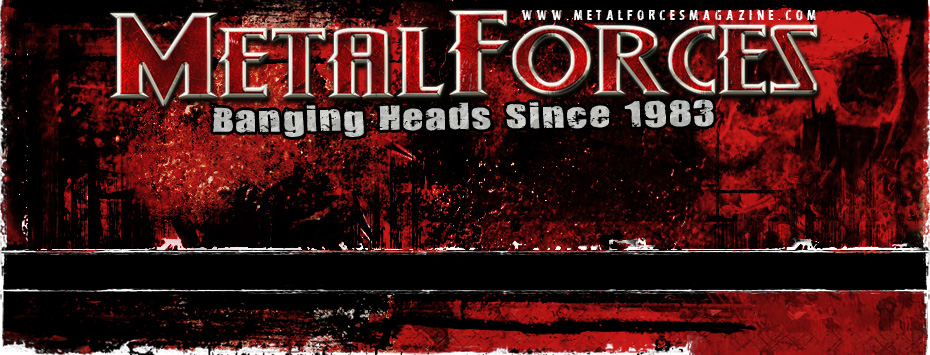
ONSLAUGHT – Chaos Is King
Anthony Morgan
September 2013
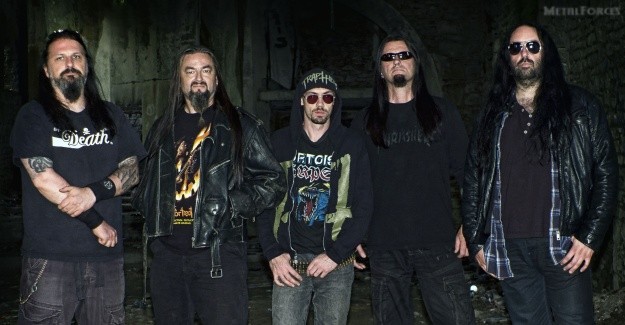
|
![]()
Sounds Of Violence – the fifth studio full-length to be issued by British thrash metal outfit Onslaught – arrived in January 2011 through AFM Records. Prior to its release, rhythm guitarist Nige Rockett and lead axeman Andy Rosser-Davies had already begun to pen material in preparation for a sixth studio affair. These writing sessions would culminate in the issue of September 2013’s VI.
“That was just to try to get ahead the game, so we didn’t get a big backlog,” supplements Nige. “Our new label wanted us to release the next one within almost two years of Sounds Of Violence. I didn’t really want too much pressure to come onto us at the end, and so yeah, we had a lot of ideas left over from Sounds Of Violence, which we built on from there. It was kind of an easy process for me and Andy really, because we had gotten to know the way the other works on the Sounds Of Violence album. When it came to write this one, it was really easy to be honest. That was nice of course, because it was gonna be a tough album to follow. We feel we’ve done a good job.
“The first song that we wrote actually was ‘Chaos Is King’ for the VI album, and it’s kind of a prequel to the track ‘Code Black’ from the previous record. If you listen to the intro of ‘Code Black’ on the Sounds Of Violence album, you will actually hear the tail part of ‘Chaos Is King’ from the new album. It’s kind of confusing a little bit. It’s more of a movie type thing, but we tried to put it into music, and I think it kind of works. The lyrics are related, and yeah, I think it’s come off kind of okay.
“We just went from there. I think it probably took around five to six months in total; if we added everything together like writing, demoing, and recording, there was five to six months of work I guess. That’s fairly quick I guess, especially for Onslaught, as we’ve generally taken three to four years between albums. We’re pleased with the way it’s gone, especially as the final result has really pleased us no end. We’re really proud of what we’ve done so far with this one.”
Onslaught’s creative well isn’t dry. “One thing Onslaught never do is, we never write…,” the composer begins. “You see a lot of bands who say ‘We wrote 12-14 songs, and we’re gonna use 10-11.’ We never do that. If it isn’t good enough, we just throw it away. But yeah, we just bounce ideas off of each other all the time. We sit down in our little studio, and one of us will bring riffs in. The other one of us will go ‘Man, let’s alter this’ or ’… Do this.’ I think it’s really a total 50 / 50 effort in terms of the music, between me and Andy. With virtually every riff we wrote, the other one would try to improve on it. That’s just the way we work.
“I write all of the lyrics and the vocal parts for the band, but musically it was me and Andy sort of 50 / 50, straight down the middle. There was never a recording session that we’ve had, where we didn’t create something positive for the album. There was never a day where we had sat there, and gone home at the end of the day without having done anything. We’re never short of inspiration, so yeah. We make a good team, I think.”
The appointment of Andy-Rosser Davies was confirmed on February 2nd, 2008, January 2011’s Sounds Of Violence marking the shredder’s debut. “Unfortunately, I think in this day and age, bands have a lot of issues with member changes,” Nige observes. “You can just look at the history of other bands, like Exodus, Testament, Anthrax, blah blah blah. I think it’s just part and parcel of being in a band. Not everybody can commit fully all of the time. We always try to make the negative of a membership change into a positive thing, and bring in somebody who actually brings more to the table. Andy definitely brought lots to the Onslaught table when he joined. As I say, we make a great writing team, and he’s obviously a fantastic lead guitarist. He’s definitely had a very positive impact on the band.”
The lyricist has concentrated on rhythm guitar duties since Onslaught’s 2005 formation, leaving lead responsibilities to a bandmate. “I used to do all of the leads back in the 80s period, but since we got back together, because I had a ten-year layoff, it was something that I didn’t wanna do when I came back,” he explains. “I concentrated more on my rhythm playing, so when we write the parts, what you will find is I do most of the rhythm parts that are on their own where the whole band drops out and stuff like that. Andy is obviously concentrating on the solos. When it comes to recording the album, I will play all of the rhythm parts on the records just for tightness.
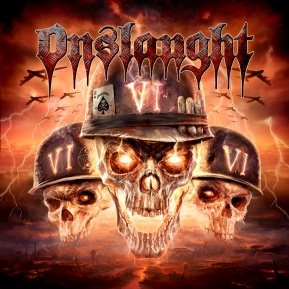
|
“That’s the way it works, but Andy will do a few little bits here and there. He’s obviously got his solos to concentrate on, and a lot of overdubs and stuff. That makes things quicker and more cost effective in the studio, especially as we’re laying down sometimes four, five, or six rhythm guitar parts. They have to be super-tight, so it’s obviously better to get one person to play all of that on record. That’s the way it’s been all the way through, and I think most bands work that way as well. Obviously there’s a big part of Andy on the record of course, but we stick to our strengths, and that’s the way we like to do things.”
Lead guitar parts were mainly supplied by Nige himself on Onslaught’s trio of 80s full-lengths. “Obviously on the first album (Power From Hell, February 1985), the leads weren’t that great anyway,” he chuckles. “We only had one guitarist, though. With the second album (The Force, May 1986) we added a second guitarist, but then I was sort of doing all of the leads then. On the Sanity album (In Search Of Sanity, August 1989) I did a big part of them, although Rob Trottman – who was our guitarist at the time – did some as well.
“Like I said, when I came back I had not played for ten years. It was really gonna take a lot of really, really hard work. It was hard enough to get the rhythm playing back up to speed, but to try to get the leads back up there as well was gonna be a bit too much, especially with the writing. There was also the fact that we weren’t able to do that full-time any more, so it was always a better option to get somebody in as a lead guitarist.”
With each respective studio outing issued since Onslaught’s reformation, the axe-slinger believes the assortment are developing more of a rhythm and becoming better and better. “We came back with Killing Peace (March 2007), which we thought was a pretty strong album,” he cites. “When Andy then joined, we got this great rhythm going between us. As I said, we made Sounds Of Violence, which I thought was our best album at the time, as did a lot of people. And as I said, we thought it was gonna be very tough to follow, but yeah, we just seem to be going from strength to strength at the moment.
“I’m planning for the next album already and this one’s not out yet, as was the case last time. I’ve got a very good feeling about the next one as well. I just don’t wanna release anything that is substandard compared to our previous albums. I’d feel disappointed for myself and disappointed for the fans if we ever did that, so we need to rise to the challenge on every album and make a better one each time.”
Fans and journalists alike inevitably weigh Onslaught’s noughties catalogue against its 80s catalogue. “It’s hard to compare because the 80s were a totally different time and era, really,” Nige cautions. “The first two albums were kind of hailed as classic albums, but I think times have moved on and the band has improved no end, really. I definitely think that as much as everybody… They used to say that The Force is the classic Onslaught album, but I’m hoping that people start changing their thinking now with Sounds Of Violence and VI. We’ve had some amazing reviews of the album thus far, and the majority of those are saying that this is Onslaught’s best album. We just hope that the fans think that way too.”
Albeit boasting roots which date back to 1983, not all thrash aficionados are aware of Onslaught’s existence. “It’s incredible really when you think about,” the axeman muses. “We’re a fairly high profile band, but obviously because Facebook is such a vast medium now, we’re still getting people who say ‘Who are this band?’ They’ve never heard of this band. It’s great, really. We’re obviously getting introduced to new fans all of the time, and hopefully the album VI is gonna expand our fanbase a great deal more. It’s incredible that some people – even in the UK and Europe – are not aware of the band, though. It’s weird, but it’s a good thing that we’re now reaching out to these people. We’re just gonna keep on pushing and pushing, and get our name out as much as possible. That’s the only way we can make this band grow even more.”
A fresh crop of thrash outfits have emerged in recent years. “Thrash has been getting stronger,” Nige admits. “We came back, and I guess it was kind of on its way up. In the last five years in particular though, with the Big Four and the likes of Testament, Kreator, Overkill, ourselves, and Exodus releasing really, really strong albums, it’s really getting a new generation of fans into thrash again. That’s great. We’re witnessing it, especially at live shows.
“There are lots of young kids there as well, which is really cool. Obviously that leads to new bands forming, which is great as well for the scene. Obviously the scene needs to keep building from the bottom. The only thing that I would say is I think some of these bands need to try to push thrash into a new direction, instead of doing what the old school bands are doing. They should just try to take thrash in a little bit of a more different direction, just to help the movement to continue once the other bands start to fade out.”
Certain newer thrash ensembles come across as more of a homage, as opposed to adding new ingredients to the thrash recipe. “Yeah, that’s right,” the guitarist agrees. “Definitely. That’s what I think they should do. It’s not easy, mind you (laughs). I don’t know how they’re gonna do it, but I think that’s what it needs for the scene to keep expanding further beyond the likes of the main bands in the genre.”
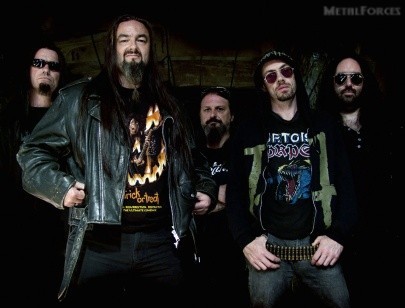
|
Nige feels each respective territory possesses its own individual thrash identity, particularly as it relates to Germany. “The German bands especially have a very distinct sound as compared to the British and American bands, I would say,” he reckons. “Even with the latest Kreator album (Phantom Antichrist, June 2012) though, I think the line is getting a little less hard. Probably because of the way things are recorded these days, I think the line is becoming a little fainter now. Obviously the language and vocal tones make a little difference. Whereas with the English and American bands, we all kind of speak in the same tongue, if you know what I mean, the Germans always have that really aggressive sounding vocal in there just because of the way they pronounce the English. I think that makes it quite distinct for them, anyway. I’m not too sure about the English side of things. There aren’t really a great deal of bands over here any more. That’s quite sad for the UK scene, really.”
Nonetheless a British concern, whether Onslaught’s musical stylings identify the group as a British thrash quintet is open to debate. “We’ve always had a hardcore punk tinge to our sound,” the songwriter references. “It’s always been based around that, because that’s where we came from and what I grew up on. There has always been that kind of influence in there, and also we came from the Motörhead side of things as well. I don’t know. It’s difficult to say. A lot of people said that the Sounds Of Violence album had quite an English feel to it, although I didn’t really hear it myself. We just write music that feels good, and sounds good. It’s not something we ever try to consciously do, to remember that we’re a British band and that we need to keep this British identity. It doesn’t work like that. We just feel that we write the best thrash metal that we possibly can.”
Despite harbouring an active thrash scene, the music industry is financially difficult within the United Kingdom. “That’s a tough question, man. I don’t know. Things are really difficult in the UK for bands, as we’ve found out since we came back,” Nige laments. “I guess we’ve probably only played a handful of shows in England since we’ve been back together, since 2006. It’s much more of a struggle than it is for us in Europe, South America, and the rest of the world even. The press are really kind of fickle in England. They kind of work in a weird way (laughs), which I don’t think is necessarily always the best for the bands. Everything we do in England is built purely on our own hard work and promotion, really. Of course we’re a British band, but I think we appear to be more international than anything in this day and age.”
Sounds Of Violence cut ‘Code Black’ lyrically relates to the number ‘Chaos Is King’, the pair concerning a dictator. “‘Code Black’ was a story about a dictator in history, and the kind of things that he was planning,” the wordsmith augments. “‘Chaos Is King’ is the prequel to that story and is basically about how he came to rise to power, whereas ‘Code Black’ was more about the era he was actually in power, and all of the evil stuff that went on then. ‘Chaos Is King’ was the fact that his ideology was to create as much chaos as possible to get himself into power, so they’re kind of linked through that way. It was something we planned. I think it works. It’s kind of cool, especially with the music, and how it ties around and goes around full circle. That’s kind of like they do in the movies, but we’ve tried it with the music. I’m happy with how it turned out.”
Nige cited ‘Chaos Is King’ as the most aggressive Onslaught tune to date. “When we recorded it, everybody really pushed themselves to the limits on this one,” he compliments. “‘Chaos Is King’ is definitely the most aggressive track. It was a real bitch to nail super-tight in the studio, but as I said, if we wanna further this band then we have to push ourselves to the limits, and that’s what we did. There’s some real, tough playing on this album, and I think everybody excelled themselves as much as possible. Sy’s vocals (Sy Keeler) were a great step forward again from the last album, if that is possible. We never thought he would do it, but he did, and I think that’s why the album turned out as strong as it has.”
A Middle Eastern flavour denotes ‘Children Of The Sand’, meanwhile, which the axe-slinger judged as being Onslaught’s most experimental track to date. “I don’t know if you’re aware or if you’ve seen on the website, but we’ve got some friends who are working out in Afghanistan,” he informs. “They actually named their battalion and missile launchers after Onslaught, and they use the Onslaught logo at their base. They just sent us some of their thoughts back over, just letting us know what it’s like out there. It was pretty heavy stuff, really, stuff that we don’t necessarily get told by our governments and what have you.
“So yeah, they sent us a lot of their thoughts and said ‘Please feel free to use any of this for lyrical inspiration,’ which I did. There are a couple of songs on VI where I took lyrical inspiration from that, ‘Children Of The Sand’ being one of them. When we actually came to write the music, it just lent itself to that Middle Eastern, Arabic kind of sound with the guitar chord progressions that we used and stuff. When we had actually finished the main part of the music and Sy’s vocals were in it, I just really wanted something else just to enhance and bring out what the song was truly about.
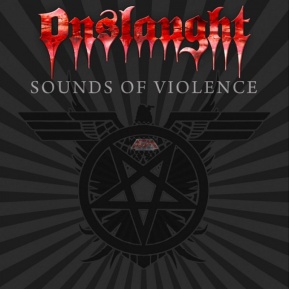
|
“We tried putting some keyboards into the song – sort of stringy keyboard sounds – but it just didn’t sound quite right. I really hate the idea of using keyboards in thrash metal, anyway. When I went to Sweden to mix the album with Thomas Johansson, I discussed it with him. He actually knew some guy there who was a fantastic string player. We got him into the studio for a couple of hours and talked through some parts, and so he actually played live strings on the album.
“It really brought the choruses to life in particular, which was absolutely fantastic. Obviously it’s really great to have a real musician play on there, rather than keyboard strings and stuff. Obviously we added the female vocals in the choruses and the intro, and it just brought the whole thing together in an amazing way. We just sat there gob-smacked when it was finally finished. I couldn’t have dreamed in a thousand years that it would’ve ever turned out that way. For me it’s one of the best songs we’ve ever done personally, anyway.”
‘Children Of The Sand’’s nature paves the way for further experimentation on future compositions. “Now we’ve done that, I think you have to in future,” Nige concedes. “Like I said earlier, we don’t wanna be seen to be standing still. We always need to keep moving forward. I have actually got an idea. I was speaking to the guys about it the other day. I have got an idea for something different on the next track again, which is something we’re gonna try to put together over the next year or so. It’s quite interesting. Obviously I don’t wanna give too much away at the moment, but if it works it could be the same kind of thing. Just something a little bit more experimental, just to give the album a different flavour. But yeah, I’m definitely gonna do something like that. As I said, the idea’s coming together nicely.”
Fellow VI numbers to touch upon the Middle East include ‘Slaughterize’. “One of the other tracks which is particularly relevant as well is ‘Enemy Of My Enemy’, which is an old Arabic saying anyway,” the axeman elaborates. “Especially with the situation that’s going on in Syria at the moment – the Americans trying to come in one side, and then all of a sudden, the Russians and the Chinese coming on the other side – that particular song and the lyrics in that song become very, very kind of relevant at the moment. It was kind of weird for us when the situation arose, because like I said, it’s just very strange. That’s kind of what that song was about, without knowing that situation was actually arising. It’s very spooky.
“It was originally written moreso about… If you look back at when Russia were actually out in Afghanistan, the Americans and I believe possibly the British government were funding and sending arms to the Taliban, so obviously they were kind of enemies with Russia. They weren’t our best friends, but they were less of an enemy. They were being helped, but then all of a sudden the tables turned, and the Taliban are our main enemy again. That’s what the story’s about. It’s been a thing through time. Nations will always take another nation who’s maybe not their best friend, but who they’ve got a common enemy with, and ally together to fight that one thing. The majority of the time it always turns full circle, and comes back the other way. It got really relevant with that, but it was based more on historical events. All of a sudden it became very modern day news too, though.”
The majority of Onslaught’s material is lyrically preoccupied with the group’s dislike of religion. “That’s basically what causes most of the wars all around the world and what’s caused them throughout the sands of time, really,” Nige argues. “I’ve got a fairly religious family, and that’s how I kind of got drawn into all of this as a kid. That’s why I dislike religion so much, but if you particularly look out there, even though we’re told it’s religion, there are a lot of other causes going on behind the scenes that we don’t really get told about.
“I’m aware of some of the situations which I can’t really say about too much, but religion is the root cause I believe. I don’t know why. It’s meant to be a free world, and everybody should be able to believe in what they like – whether they believe in religion or not. For some people though, it seems like they have to force their beliefs on other people. That’s where all this trouble stems from – as far back as time I think, from what I can see.”
Related Posts via Categories
- ONSLAUGHT – Live Forces (March 2016) | Features / Interviews @ Metal Forces Magazine
- ONSLAUGHT – Chaos Is King, Part Two (September 2013) | Features / Interviews @ Metal Forces Magazine
- SCOTTISH SICKNESS – A Report On The Scottish Death Metal Scene, Featuring BRAINBATH, PUTRID FATE And RANCID CADAVER (October 2022) | Features / Interviews @ Metal Forces
- LARVAE – Join The Hardcore Cult! (June 2022) | Features / Interviews @ Metal Forces Magazine
- TRENCH FOOT – Sacrificing Morals For Gory Obscenities (June 2022) | Features / Interviews @ Metal Forces Magazine
- L.A. GUNS – Trigger Happy (March 2019) | Features / Interviews @ Metal Forces Magazine
- CANCER – Crimes So Evil (November 2018) | Features / Interviews @ Metal Forces Magazine
- U.D.O. – The Tank Drives On (August 2018) | Features / Interviews @ Metal Forces Magazine
- SIEGE OF POWER – Bleeding For The Cause (August 2018) | Features / Interviews @ Metal Forces Magazine
- MOONSPELL – A Taste Of Live Eternity (August 2018) | Features / Interviews @ Metal Forces Magazine
|
|
